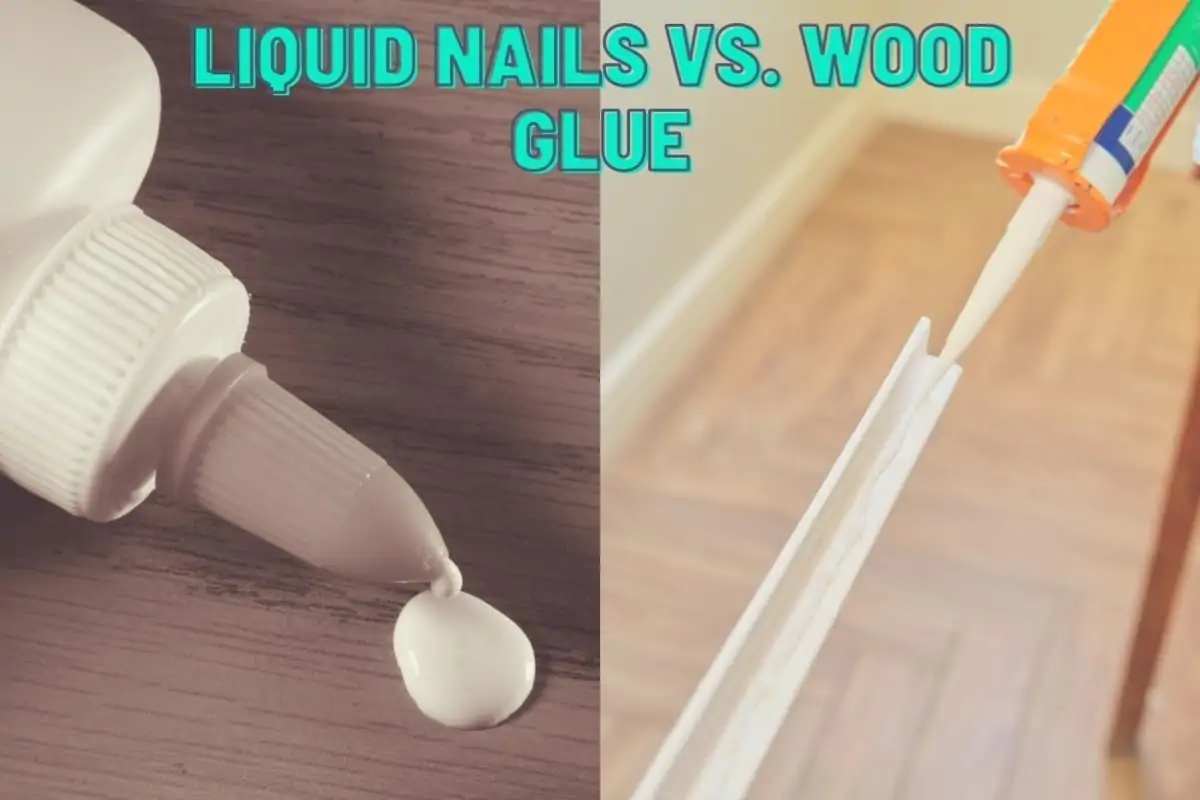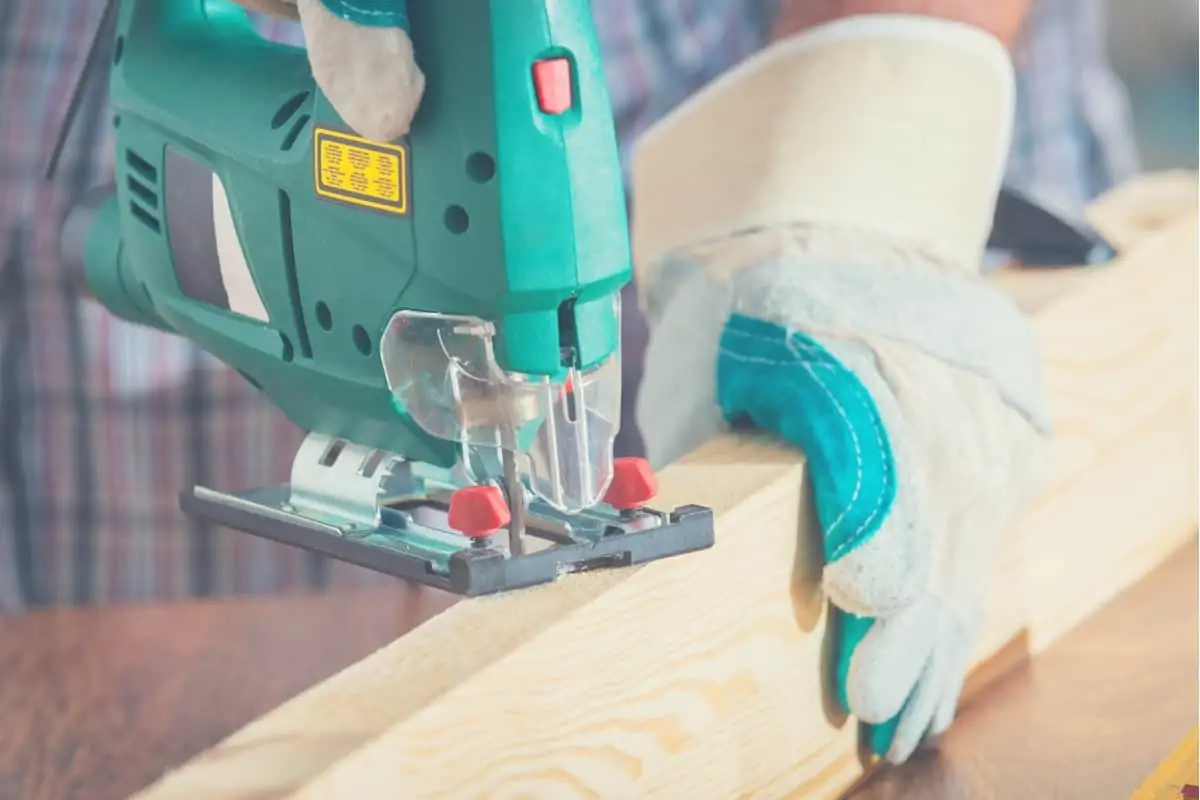If, like me, you spend plenty of time on woodworking projects, you might already be familiar with the debate of liquid nails vs wood glue.
But which is better? And are there situations when one is more effective than the other? These are the questions I’ll answer in this article along with the most useful, definitive information about each product.
While traditional wood fixings, such as nails and screws, serve a purpose, there are many situations in which wood glue is a more practical and easier option.
Hopefully by the end you’ll know exactly when to use liquid nails vs wood glue.
Wood Glue
Wood glue realistically shouldn’t need much of an explanation; the key is in the name.
It refers to a range of different products that are effective at bonding together 2 bits of wood. Many different wood glues have been used throughout human history.
In fact, the earliest types of wood glue date back as far as 2000 BC. These were made from animal products – particularly collagen from boiling hides – and have excellent adhesive properties.
While animal glues are still used in a few specialist industries, such as musical instruments and woodwork conservation, synthetic glues have become the more popular choice.
Along with being cheaper to produce, they have much better adhesion than animal-based glues. What’s more, they’re of course more ethically sound products.
The most popular types of wood glue are:
1. Polyvinyl acetate (PVA)
PVA is perhaps the most widely recognized synthetic wood glue. It’s also known as white glue or hobby glue thanks to its wide availability and ease of use. Most people will remember this as school glue on account of it being the go to glue for school arts and crafts.
It’s non-toxic and has good hold. But it’s difficult to repair because once hardened it provides a very poor surface for adhesion.
2. Epoxy resin
Epoxy resin is another common type of wood glue. It comes in 2 tubes and must be mixed before use. It bonds quickly and under a wider range of conditions than other popular wood glues.
Its main benefits include high temperature resistance (up to 350 degrees F) and resistance to salt water.
Epoxy is also great at filling gaps and can result in near invisible joins, unlike other wood glues.
Some formulas have added metal or rubber to improve their shock resistance and toughness. There are different formulas for a variety of joining applications.
Its main disadvantages are price and convenience. Mixing requires careful attention, as getting the ratio wrong can result in a poor bonding solution.
3. Polyurethane
Polyurethane glue is a popular branch of wood glue that can be used in a wide variety of bonding and joining applications. It’s suitable for gluing materials such as textiles, glass, and ceramics, as well as wood.
In short, polyurethane is an all-purpose glue.
It cures by reacting with moisture, much like superglue. Polyurethane is particularly effective at bonding wood-plastic polymers.
4. Cyanoacrylate
Commonly known as superglue, cyanoacrylate is designed for small spot repairs rather than larger joining projects.
It bonds almost instantly, which is both good and bad. It’s not the sort of glue you want to go squeezing all over your workstation!
Superglue is mainly used in smaller projects, such as model building as other glues mentioned above form stronger bonds in larger joins.
5. Aliphatic resin
Also known as carpenter’s glue, this is a more resistant alternative to PVA. It’s ideal for bonding wood because it sets quickly and is usually the same color as wood.
It sets faster than PVA and is more viscous, so it’s easier to use in complex projects where you want to avoid excess spillage.
The only major disadvantage is that it can’t be used outdoors.
Other less popular wood glues include:
- Urea-formaldehyde (low cost but produces formaldehyde when it deteriorates).
- Resorcinal-formaldehyde (dark purple color, potential carcinogen).
- Phenol formaldehyde (good for bonding plywood).
Of course, some types of wood glue are better in certain situations. Their different bonding times and strengths can help you to determine which glue is best for a certain application.
Uses and Compatible Materials
Wood glue can be used on any type of wood. But the type of wood will dictate the type of wood glue you use.
For example, raw (untreated) wood will be more susceptible to the glue soaking into the material, while varnished wood will require a stronger bonding glue.
PVA glue is best for standard joining projects when it’s a clean join between 2 bits of untreated wood.
Epoxy is better for mismatched joints as it can fill small gaps. Also, it’s waterproof, so is fine for outdoor projects.
Similarly, polyurethane glue is suitable for indoor and outdoor applications but it can impact the appearance of joints.
You can use wood glue instead of nails, but you’ll have much better results if you use both together. Wood glue is great for securing a join or fixing a crack, but won’t have the same long-term security as a few nails. It’s best to glue the join, let it cure, and then add some nails to finish.
It’s entirely possible to just glue wood rather than using other fixing methods. But if the joint will be put under stress, you’ll have better results if you finish it with screws or nails. Using a combination of glue and traditional joints and fixing methods will give a good balance between strength and flexibility.
You should use wood glue when securing large bits of wood, or when screws and nails might not be practical. For example, wood glue is great for things like fixing skirting board because it doesn’t leave any marks.
Wood glue is also great for the following uses:
- Decoration (where you don’t want any visible fixings).
- Craft projects.
- Reinforcing joints or screws/nails.
Strength
Many wood glues claim to be stronger than the material they’re gluing. While this is great, it doesn’t really mean much.
Depending on the joint, wood glues can withstand quite a lot of force before they break.
But on its own, wood glue might not offer the kind of strength you expect. They’re most effective when combined with screws, nails, or a traditional joint (butt, scarf, tenon and mortis).
You can check out this video for some tests on the strength of different wood glues.
When it comes to the lifespan of wood glue, it really depends on the type. I’ve seen PVA glue that has lasted for over 50 years while animal glues can break down before then. Modern synthetic glues, in the right conditions, could easily last 100 years or more.
Drying Time
Wood glue can take as little as 20 minutes to dry, but most types require at least an hour before they’re considered touch dry.
That said, wood glue usually takes between 24 hours and a week to fully cure. PVA and aliphatic resin will be fully cured in about a day.
It’s best to apply some clamps to the wood during the initial stages of drying. This helps to form a more secure bond between the 2 surfaces.
You should leave the clamps on for at least an hour. For stressed joints, leave the clamps on for 24 hours before removing, and then don’t apply any stress to the joint for another 24 hours.
If you plan on sanding the wood glue, be sure to leave it at least 24 hours before doing so. This will be enough time for it to dry sufficiently, although not all wood glues can be sanded after drying (PVA, for example).
For the most relevant information on the type of wood glue you’re using, always check the label first.
Fumes and Safety Measures
PVA is a non-toxic wood glue and doesn’t produce any fumes while bonding. Glues such as epoxy resin and aliphatic resin should be used in a well-ventilated area, but are generally non-toxic.
That said, always be mindful of proper safety measures. Wear safety glasses and gloves at the very least, and a respiratory mask if working with a solvent-based glue.
Of course, always keep wood glue out of reach of children and ensure it’s stored properly in an airtight container in a cool area.
Pros and Cons
Wood glue is a fairly good all-round product that’s useful in most bonding situations. But there are some cons to wood glue too.
Consider this list of pros and cons to see whether wood glue is right for your project.
Pros of Wood Glue
- Wood glue has a fairly quick drying time.
- Generally non-toxic and safe for regular use.
- Good bonding strength for reinforcing joints and repairing small cracks.
- Wide variety of types for different projects and applications.
- Inexpensive and readily available.
Cons of Wood Glue
- Be mindful of indoor and outdoor use.
- Some types of wood glue (PVA) can’t be repaired or reworked later down the line.
Liquid Nails
Liquid Nails is in fact a brand name for simple construction adhesive. It’s a certain kind of construction adhesive that provides amazing bonding strength, particularly on non-porous surfaces.
Liquid Nails is better than wood glue when working with non-porous surfaces, such as varnished or painted wood. It’s also a better choice when it might not be practical to clamp the materials because it has a faster bonding time.
Some construction adhesives are latex-based, meaning they’re non-toxic and can be used indoors and outdoors.
Older types of construction adhesive are solvent-based, which is useful for bonding certain materials, such as plastic and varnished wood.
Uses and Compatible Materials
Liquid Nails is compatible with non-porous wood, but also with:
- Plastic.
- Metal.
- Ceramic.
- Vinyl.
Its main uses over wood glue are when you need to quickly bond 2 materials together, particularly if one isn’t wood.
Wood glue will still be the preferable option if you’re working with raw wood or for stressed joints. Liquid Nails has great adhesion but won’t reinforce a stressed joint like wood glue will.
Construction adhesives are also good for filling small gaps in joins. While it won’t add much to the join’s strength, construction adhesive can often be sanded and painted easier than wood glue.
Strength
Liquid Nails is a strong adhesive, providing there isn’t stress put on the 2 surfaces. For example, it’ll be great for sticking skirting board to a wall, but won’t be great for reinforcing a stressed joint.
Construction adhesive can also be prone to separation over time, whereas wood glue isn’t.
But construction adhesive holds strong in high-moisture situations, such as gluing subfloor to joists. While you can find wood glues suitable for this, construction adhesive can be a convenient option.
In short, Liquid Nails is good for quick applications, but for wood-on-wood bonding, it doesn’t have the same kind of strength you’d get from a good wood glue.
It’s the preferred option for gluing non-porous materials together, such as wood to ceramic or vinyl.
Drying Time
One of the main benefits of Liquid Nails is that it bonds very quickly. On the right surfaces, you can remove pressure after only a minute, if you even needed to apply any in the first place.
But it does take a while to cure. Latex varieties can take up to a week to fully cure, which isn’t vastly different from wood glue.
If you can clamp the 2 surfaces during early bonding, you’ll end up with a better join once it cures.
Another advantage is that it’ll last for a long time without breaking down. Latex construction glues can last indefinitely, although some solvent-based versions are prone to separating over time.
Fumes and Safety Measures
Latex-based construction adhesive is non-toxic and doesn’t produce fumes while it’s drying. Getting it off your skin can be difficult, so be sure to wear gloves.
Solvent-based glues are toxic and emit fumes, so only use these in well-ventilated areas. Make sure you wear a mask during application too.
Safety glasses are a no-brainer regardless, as is storing the product correctly.
If you do get latex-based adhesive on your skin, just wash with soap and water. Solvent-based glue first needs to be rubbed with petroleum jelly and then washed with soap and water.
The process is fairly similar for removing it from surfaces too.
Pros and Cons
Like wood glue, there are some pros and cons of Liquid Nails you should know before you start using. Here are the main ones.
Pros of Liquid Nails
- Bonds very quickly and doesn’t always need pressure.
- Latex-based versions are waterproof – can be used outdoors.
- Good for filling gaps between materials.
- Suitable for bonding non-porous materials.
- Latex-based glues retain flexibility once cured.
- Easy to paint over.
Cons of Liquid Nails
- Not suitable for wood-on-wood applications.
- Can be toxic.
- Doesn’t offer the same kind of strength in wood applications.
Liquid Nails vs. Wood Glue – So Which is Best?
When it comes to the question of which is best in liquid nails vs. wood glue, the answer depends on your project.
If you’re working with raw wood then I’d recommend wood glue every time. There are various types for indoor and outdoor applications, and they offer excellent bonding strength and durability.
But if you’re working with treated wood and/or non-porous materials, Liquid Nails will be the better choice. It bonds quickly and effectively, providing the bond isn’t under any real stress.
I find I get through a lot more wood glue than construction adhesive, but it’s always useful to have a bottle of each lying around.
What’s your view on the classic liquid nails vs. wood glue debate? Leave a comment below and see if others share your opinions.




We are going to apply a piece of wood to our wall to install the railing, we have a lack of studs due to the age of the home and will need to have the wood laid first so we can have a stronger adherence to the wall to stablize the railing. We tried the plaster wall thing and it did not work and researching we are hoping adding the wood to the wall will anchor it better. Just wondering what the best would be used wood glue or liquid nails and what is the best to do? Would we apply the wood and wait a couple of weeks to set the railing? Would we tape the wood to the wall until it cures? Any help would be greatly appreciated.